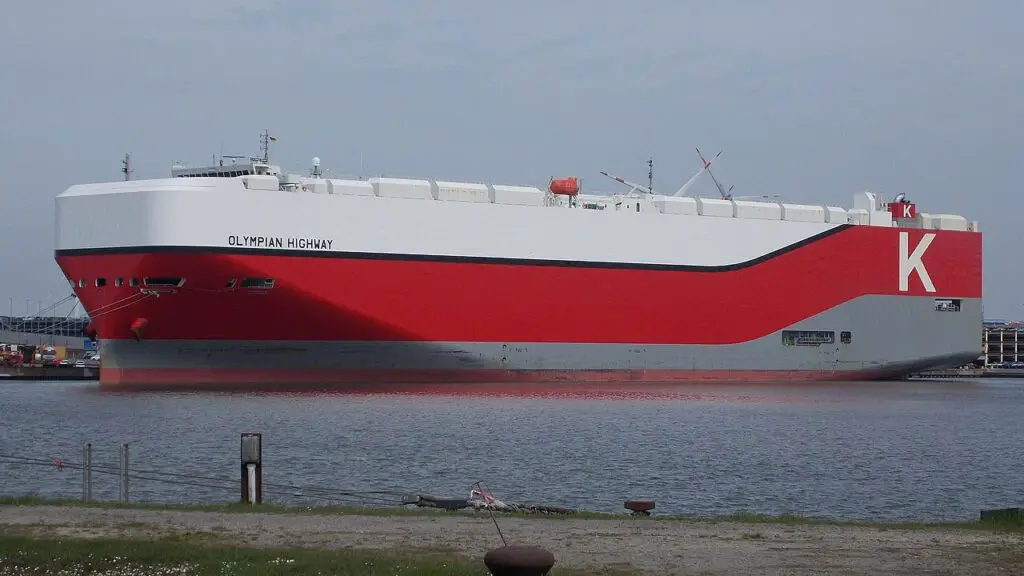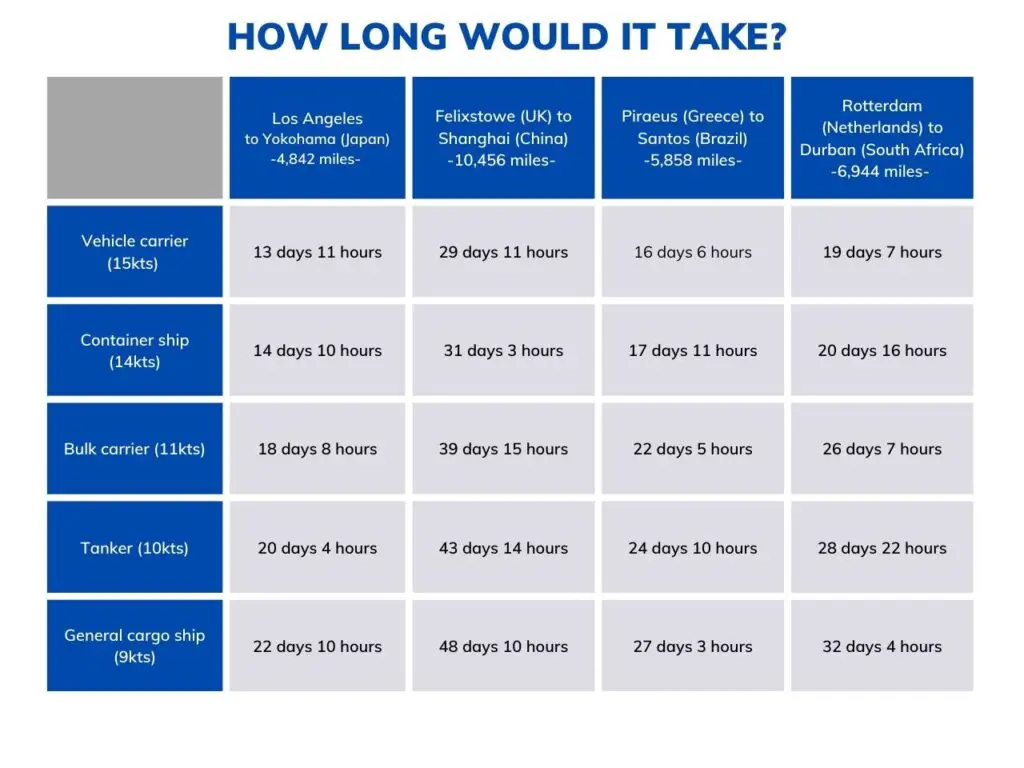Cargo Ship Comparison: How Far Can They Go In A Day?
The mass transportation of cargo across the globe would not be possible without cargo ships. A container ship sailing at full speed in a straight line for 24 hours – across the Pacific Ocean, for example – could theoretically cover around 600 nautical miles, which is equivalent to 690 land miles.
Given that it would take a jet cargo plane less than 90 minutes to cover the same distance, are cargo ships really the optimal way of transporting cargo?
| Transport type | Typical maximum speed |
|---|---|
| Cargo ship | 25 knots (29 mph) |
| Jet cargo plane | > 500 mph |
| Freight train | 75 mph |
| Articulated lorry | 60 mph |
Looking at the table above, it appears that cargo ships are by far the slowest mode of transporting goods over long distances. In order to understand why this is not the case, we must look at the important advantages which cargo ships have over planes, trains, and automobiles.
Because 71% of the Earth’s surface is covered in water, ships can travel great distances between countries via much more direct routes than trains or heavy goods vehicles (HGVs). An additional advantage is that ships have multiple crew onboard, and can therefore operate safely 24 hours per day.
An HGV may have a maximum speed of 60mph, but in reality its average speed will be much less than that. An HGV driver frequently travelling long distances at 60mph on the motorway will find that their actual average speed is below 30mph due to the start/stop nature of driving. Ships do not have to deal with traffic lights, roundabouts, or junctions – a major advantage!
Although aeroplanes have a huge speed advantage, they simply do not have the ability to transport cargo in any meaningful volume when compared to a cargo ship.
Did You Know: Ships and aircraft measure distance in nautical miles. 1 knot is equal to 1 nautical mile per hour. To learn more, check out our article: What Is A Nautical Mile And Why Is It Used?
The largest aeroplane ever built was the Antonov An-225 Mriya, and its primary purpose was the transport of cargo. This plane could carry a maximum of 250 tonnes of cargo, burning 20 tonnes of fuel per hour.

In comparison, the world’s largest container ship, Ever Alot, has a deadweight tonnage of 241,000 tonnes, and consumes significantly less fuel than the Antonov An-225 Mriya to carry almost 1,000 times more cargo.
Cargo ships are not designed for the quick transport of goods, but rather the mass transport of goods in the most efficient manner possible.
Do all cargo ships sail at the same speed?
Different types of merchant ships are capable of travelling at different maximum speeds, and they also have varying average speeds. For example, vehicle carriers and container ships tend to operate on more direct liner routes and can therefore travel at higher and more consistent speeds.
| Ship type | Average speed |
|---|---|
| Vehicle carrier | 15 knots |
| Container ship | 14 knots |
| Bulk carrier | 11 knots |
| Tanker | 10 knots |
| General cargo ship | 9 knots |
Despite these seemingly low average speeds, some cargo ships are built for speed. Maersk Boston is the world’s fastest container ship, capable of travelling at 36.5 knots. She is, however, a relatively small vessel with a maximum carrying capacity of only 4,196 TEU (the world’s largest container ship Ever Alot can transport over 24,000).

Most cruise ships have a maximum speed of just over 20 knots, although there are some that are capable of much higher speeds. Queen Mary 2, for example, can sail at 30 knots on her transatlantic liner service between Southampton and New York.
To learn more about the different speeds of cargo ships, check out our article: Cargo Ship Speed Comparison: How Fast Do They Go?
How far could different ships travel in a day?
As we now know, the average speed of cargo ships varies depending on their type.
| Ship type | Distance travelled in 24 hours |
|---|---|
| Vehicle carrier | 360 miles |
| Container ship | 336 miles |
| Bulk carrier | 264 miles |
| Tanker | 240 miles |
| General cargo ship | 216 miles |
Based on the speeds above, here are some examples of how long it could take each type of cargo ship to sail between some of the busiest container ports in the world. Each voyage is based on the quickest possible route. For example, the distance shown for Felixstowe to Shanghai is for a voyage via the Suez Canal.

Why don’t ships just always travel at full speed?
Shipping companies have three priorities when it comes to how their ships are navigated: safety, punctuality, and fuel economy. They want their ships to arrive on time and by burning as little fuel as possible.
As an incentive, it is common for shipping companies to provide a bonus to Captains who are able to save money on fuel while still arriving in port on time. This is a particularly common arrangement on cruise ships, which spend less time in port than cargo ships on average.
On certain cruise ship itineraries, for example in the Caribbean, it may not be very far between ports. This means that the required sailing speed to get from one port to the next can be very low.
This allows cruise ships the opportunity to ‘slow steam’ between ports. There are many benefits to slow steaming, but slow steaming isn’t just for cruise ships.
Over the last fifteen years, slow steaming has become more and more popular for cargo ships due to the financial and environmental advantages it offers. Check out our video learn about slow steaming and why it’s become so popular:
All merchant ships must abide by the Convention on the International Regulations for Preventing Collisions at Sea, more commonly known as the COLREGS or Rules of the Road.
One of the most important rules states that ships proceed at a ‘safe speed’ at all times. There is no specific numerical speed limit prescribed – it is up to the ship’s Captain and officers to judge what is an appropriate safe speed based on a number of factors including but not limited to the amount of traffic in the area, the depth and width of the water, and visibility.
It is generally considered that when other ships are in the area, a slow speed is a safe speed. This is because it gives the navigators more time to think and act, it allows the ship to be stopped more effectively, and if a collision does occur, the damage will be less.
Ports and harbours, however, will have their own numerical speed limits – usually in the range of 6-10 knots. This is not only because of the closeness of hazards when in port, but also because a speed of above 6 knots is not considered safe when using or interacting with tugs in harbour.
Unless a ship is sailing in open seas with no traffic interfering with her passage, it is unusual for a ship to sail at full speed. One of the few exceptions to this would be the cross-channel ferries which regularly cross the English Channel at speeds in excess of 20 knots – but in these circumstances, the officers onboard are experts at navigating in these busy waters at such speeds.
